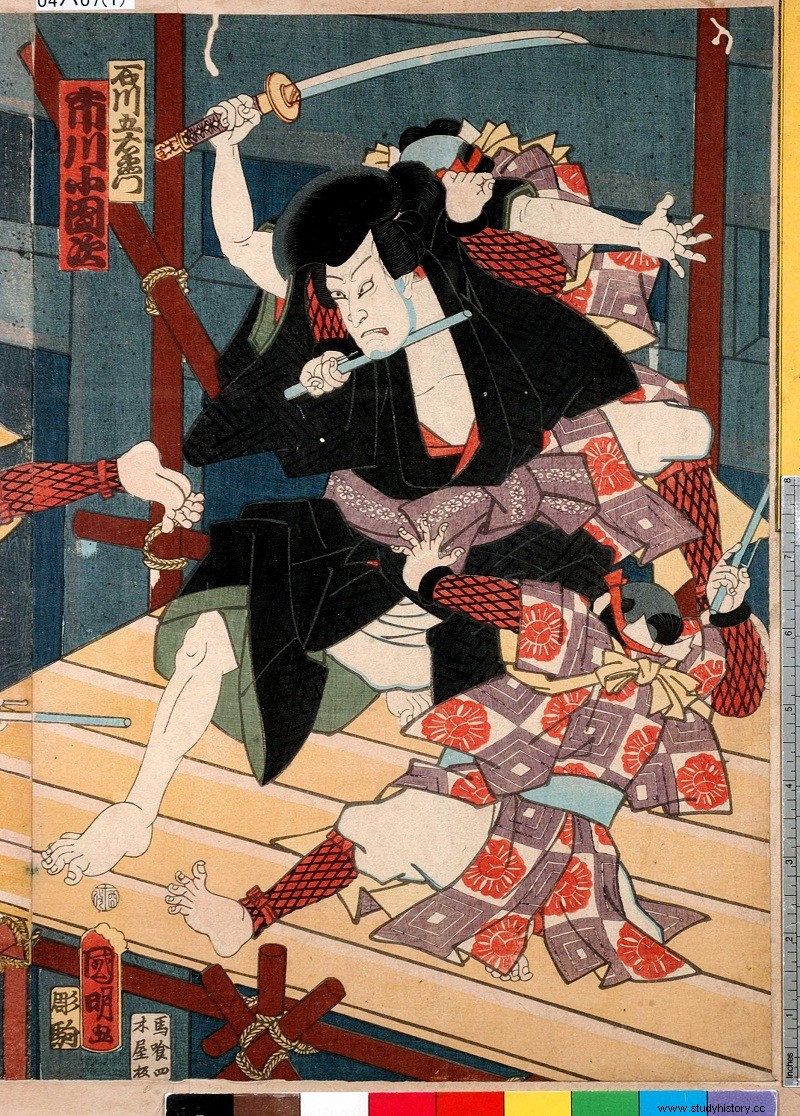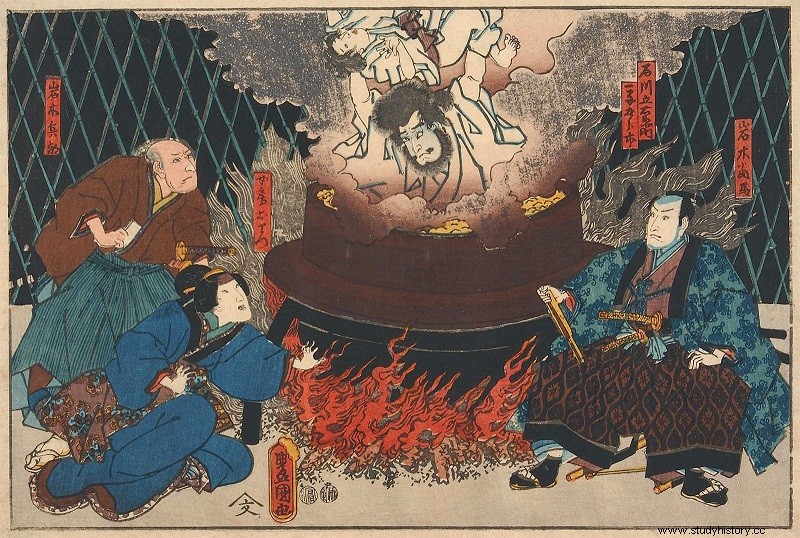The friends of the alien have existed in all times and places and, if we take a look at the newspapers, we see that they are not exactly in danger of extinction. But there have always been classes and, among so many small-time swindlers and swindlers, there are also bandits who have ended up becoming true heroes of legend. Our protagonist today is one more in that list of mythical names that goes from Robin Hood to Bonnie &Clyde and other legendary outlaws. We are talking about Ishikawa Goemon , a white-collar thief who spread terror among the wealthy in and around Kyoto at the end of the 16th century. So notorious were his blows that he became little less than the public enemy number of his time. But, as the saying goes, crime always ends up paying in the end. Unfortunately for Goemon, he was going to end up literally scalded from so much robbery.

Goemon
Goemon had a life (and above all a death) worthy of the best novel. Everything has been said about him:some paint him as a champion of the underprivileged who stole from the rich to distribute the loot among the poor; others say he was a former ninja (raised by the no less legendary Momochi Sandayu ), whom the recent unification of the country had left unemployed and, with no wars to fight, he was forced to steal to earn his rice. The most plausible story paints him as the second son of a small-time samurai family who, after falling into disgrace due to a shady robbery-murder affair, couldn't think of a better way to get ahead than to throw himself into the bush. and become a bandit. There are versions for all tastes, and surely they all have some truth to them.
The little we know about him for sure is told by a man from Valladolid, Father Pedro Morejón , a Jesuit missionary who, in those days, was in Japan fishing for souls for the greater glory of the Lord. Although, in reality, Morejón only arrives in time to tell us about his last moments:
The incident happened in 1594. A certain Ixicava Goyemon and nine or ten of his relatives were boiled in oil.
We don't know if the oil was olive oil or soybean oil, but in any case, it must have been a pretty nasty death. The execution took place in Kyoto, the country's capital at the time, and was reportedly a hit with the public. People from the most distant provinces came to see how that indomitable bandit was being cooked over a slow fire in a huge cauldron. As a condiment for the ghoulish stew, they seasoned the pot with his own son, whom Goemon tried to keep safe from the flames until his last breath. To accompany the stew, several relatives and cronies were also passed through the fire. A resounding end for the most famous gang of thieves of the moment.

Such an ordeal seems a bit excessive to us to execute a simple thief, but Goemon was not just any chorizo. His favorite clientele were the potentates of the time:wealthy merchants, great feudal lords, bigwigs of the clergy... There was no wall high enough or gate strong enough in all of Japan to stop him. Meanwhile, the common people watched with sympathy as he and his gang of alien friends cleaned out the safes of Kyoto's bigwigs with impunity. Goemon's fame was growing visibly, but at the same time he was making very powerful enemies.
Among them was none other than Toyotomi Hideyoshi , the lord and master of the newly unified Japan. Legend has it that, outraged at the despotic turn Hideyoshi's rule had taken, Goemon used his ninja skills to sneak into Fushimi castle itself. , his official residence in Kyoto, and slit his throat while he slept. But it is seen that, to have been a ninja, he was a bit clumsy, because he was not very good at moving in stealth. In the darkness he ended up knocking over a censer with a kick and the noise instantly alerted the entire garrison who descended on him before he could even approach the tyrant's quarters. Surely all this is nothing more than a nice story, since neither Goemon nor anyone in his right mind would have thought of attacking the most powerful man in the country in his own castle. But the ninja thief had become such a fabulous figure that no feat, no matter how insane, was too small for him. His gruesome ending, cooked in his own juices, would only add to his legend.
The image that has remained of Goemon for posterity is a mixture between Robin Hood and Arsène Lupin , a gentleman thief, a feudal Japanese dandy who loves expensive luxuries but, at the same time, has a heart of gold. A rebel who laughs at danger and likes to challenge the rich and powerful, with a cheeky and brash edge. The kabuki theater finished consecrating him, turning him into a recurring character and giving him his characteristic toupee, an unmistakable hallmark from then on. From then to the present day, Ishikawa Goemon She has been one of the most recognizable heroes in Japanese popular culture. His name will sound familiar to some readers, since even today it is easy to find him as the protagonist of video games, movies and cartoons.



400 years after his gruesome end, Goemon is still very much alive. As an example, a button:today, not without a certain temper, the Japanese call bathtubs made of metal “Goemon Buro ”, that is, Goemon-style bathrooms , remembering the pot in which they simmered it. They are hardly used anymore in private homes, but it is still possible to see them in public spas and hot springs. With the fondness that the Japanese have for bathing with water at impossible temperatures, it would not be strange that the least expected day someone ends up marking a full-fledged Goemon. But no matter how scalded it is, it's unlikely to become as famous as the last bath of this intrepid Japanese Robin Hood.

Collaboration of R. Ibarzabal
Source:Relationship of the Kingdom of Nippon they call Corrupting Japan – Bernardino of Avila; Ninja Attack – Matt Alt and Hiroko Yoda
